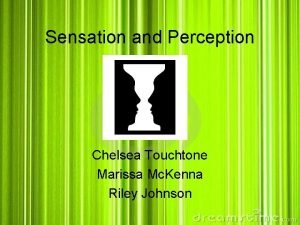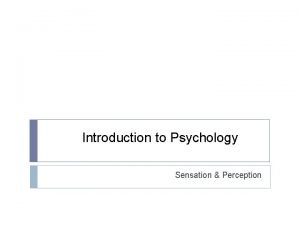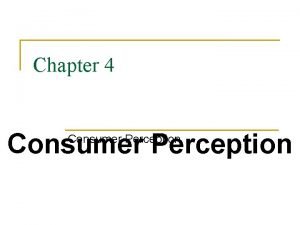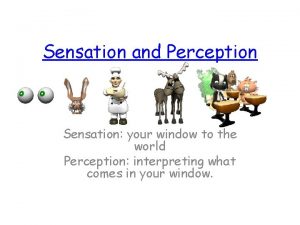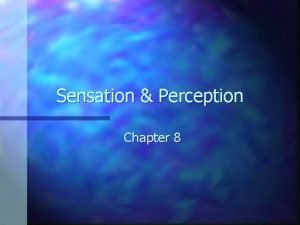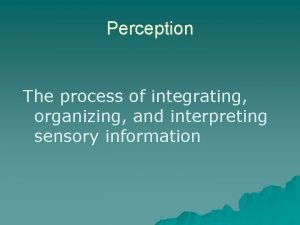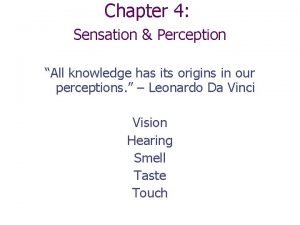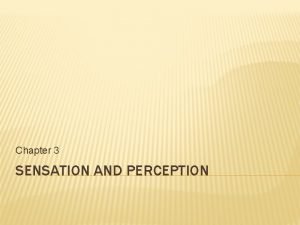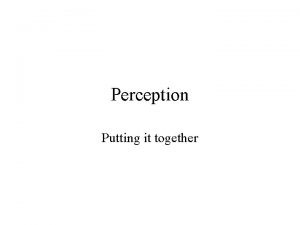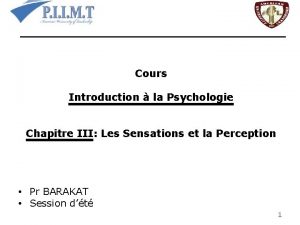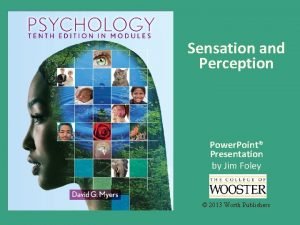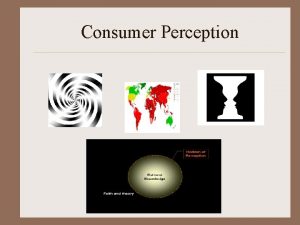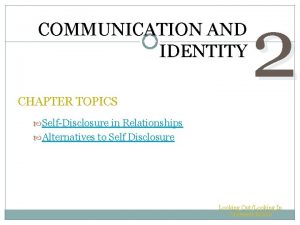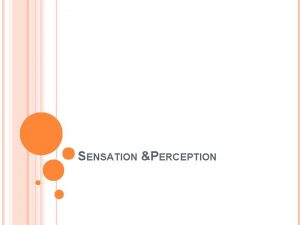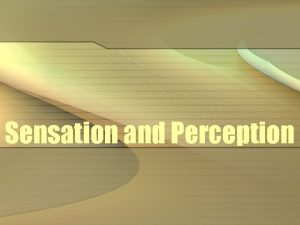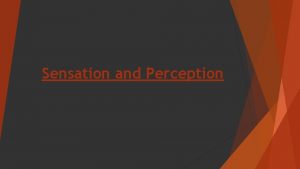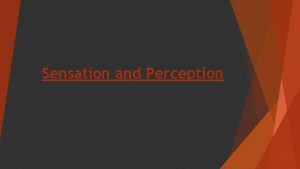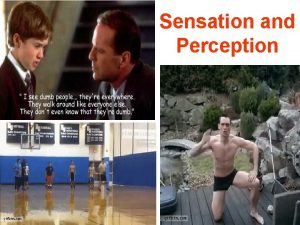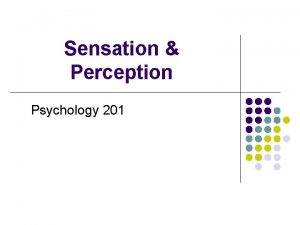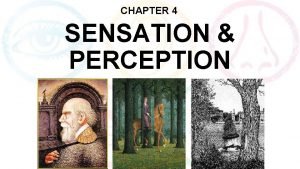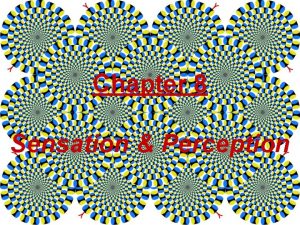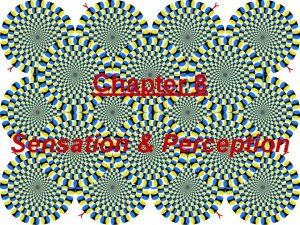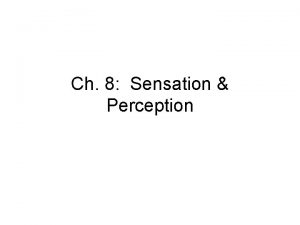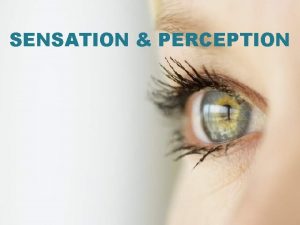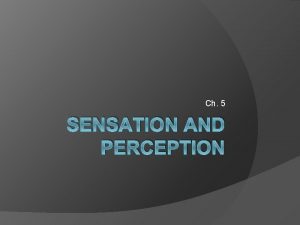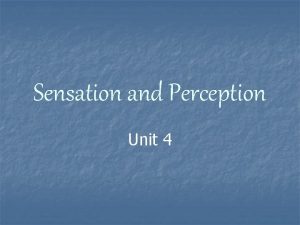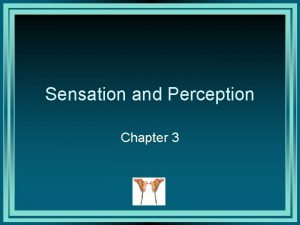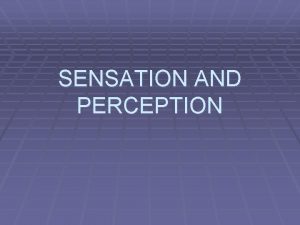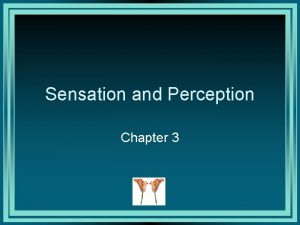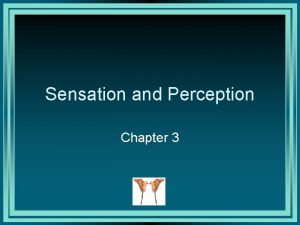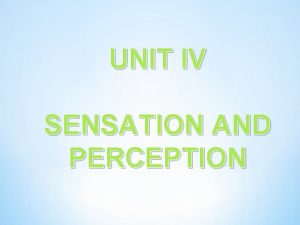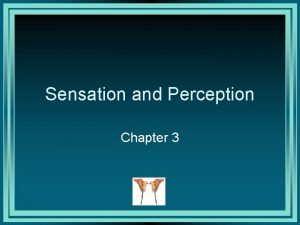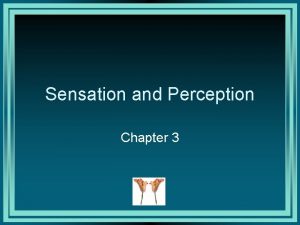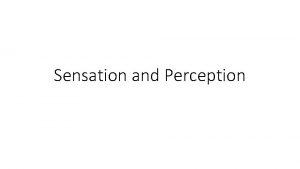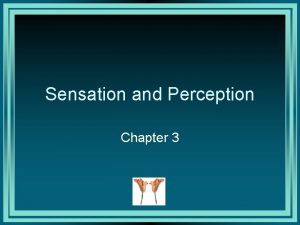Sensation Perception Sensation and Perception Sensation The process

























- Slides: 25

Sensation & Perception

Sensation and Perception • Sensation – The process through which the senses pick up visual, auditory, and other sensory stimuli and transmit them to the brain; sensory information that has registered in the brain but has not been interpreted • Perception – The process by which sensory information is actively organized and interpreted by the brain

Perception Gestalt principles of perceptual organization • Figure-ground – Organization depends on what we see as figure (object) and what we perceive a ground (context). • Similarity – Objects that have similar characteristics are perceived as unit. • Proximity – Objects close together in space or time perceived as belonging together. • Continuity – We tend to perceive figures or objects as belonging together if they appear to form a continuous pattern. • Closure – We perceive figures with gaps in them to be complete.

Perception • You can see a white vase as figure against a black background, or two black faces in profile on a white background

Perception

Perception • Perceptual constancy – The tendency to perceive objects as maintaining stable properties (e. g. , size, shape, brightness, and color) despite differences in distance, viewing angle, and lighting – Size constancy • Perceiving objects as being about the same size when they move farther away – Shape constancy • Perceiving objects as having a stable or unchanging shape regardless of changes in the retinal image resulting from differences in viewing angle

Perception

Perception • Monocular depth cues – Depth cues that can be perceived by only one eye – Types of cues • Interposition – When one object partly blocks your view of another, you perceive the partially blocked object as farther away • Linear perspective – Parallel lines that are known to be the same distance apart appear to grow closer together, or converge, as they recede into the distance

Perception • Monocular depth cues – Types of cues • Relative size – Larger objects are perceived as being closer to the viewer, and smaller objects as being farther away • Texture gradient – Near objects appear to have sharply defined textures, while similar objects appear progressively smoother and fuzzier as they recede into the distance • Atmospheric perspective – Objects in the distance have a bluish tint and appear more blurred than objects close at hand

Perception • Monocular depth cues – Types of cues • Motion parallax – When you ride in a moving vehicle and look out the side window, the objects you see outside appear to be moving in the opposite direction – Objects seem to be moving at different speeds – those closest to you appear to be moving faster than those in the distance – Objects very far away, such as the moon and the sun, appear to move in the same direction as the viewer

Perception • James Gibson – Pointed out that our perceptions of motion appear to be based on fundamental, but frequently changing, assumptions about stability – Our brains search for some stimulus in the environment to serve as the assumed reference point for stability – When you’re driving a car, you sense the car to be in motion relative to the outside environment

Perception • Depth perception – The ability to see in three dimensions and to estimate distance • Binocular depth cues – Depth cues that depend on two eyes working together – Convergence • Occurs when the eyes turn inward to focus on nearby objects – the closer the object, the greater the convergence – Binocular disparity (or retinal disparity) • Difference between the two retinal images formed by the eyes’ slightly different views of the objects focused on

Perception • Ambiguous figures – Can be seen in different ways to make different images – Best known ambiguous figure is “Old Woman/Young Woman, ” by E. G. Boring

What do you see? Now what do you see? Copyright © Allyn & Bacon 2005

Perception • Impossible figures – Do not seem unusual at first – Figures that cannot be built

Perception

Perception • Illusion – A false perception of actual stimuli involving a misperception of size, shape, or the relationship of one element to another

Perception l Müller-Lyer Illusion – The two lines above are the same length, but the diagonals extending outward from both ends of the lower line make it look longer than the upper line

Influences on Perception • Bottom-up processing – Information processing in which individual components or bits of data are combined until a complete perception is formed • Top-down processing – Application of previous experience and conceptual knowledge to recognize the whole of a perception and thus easily identify the simpler elements of that whole

Influences on Perception

Influences on Perception

Influences on Perception • Perceptual set – An expectation of what will be perceived, which can affect what actually is perceived • David Rosenhan – David Rosenhan and some of his colleagues were admitted as patients to various mental hospitals with “diagnoses” of schizophrenia – Once inside, they acted normal but the staff members only saw what they expected to see and not what was actually occurring – The real patients were the first to realize that the psychologists were not really mentally ill

Influences on Perception • Inattentional blindness – The phenomenon in which we miss an object in our field of vision because we are attending to another

Influences on Perception • Simons and his colleagues – Showed participants a videotape of a basketball game in which one team is uniformed in white and the other in black – Instructed them to count how many times the ball was passed from one player to another either on the white or black team – About a third of participants typically fail to later recall the presence on the screen of even extremely incongruent stimuli (e. g. , a man dressed in a gorilla costume) under such conditions

Influences on Perception • Social perception – Facial expressions, the visual cues for emotional perception, often take priority over the auditory cues associated with a person’s speech intonation and volume, as well as the actual words spoken
 Chapter 5 sensation and perception
Chapter 5 sensation and perception Gestalt theory of visual perception
Gestalt theory of visual perception Ap psych sensation and perception
Ap psych sensation and perception What are sensations
What are sensations Perception
Perception Chapter 3 sensation and perception
Chapter 3 sensation and perception Sensation and perception
Sensation and perception Chapter 6 sensation and perception
Chapter 6 sensation and perception Copyright ?
Copyright ? Sensation and perception in marketing
Sensation and perception in marketing Sensation and perception
Sensation and perception Sensation and perception
Sensation and perception Five basic tastes
Five basic tastes Chapter 8 sensation and perception
Chapter 8 sensation and perception Sensation and perception uu
Sensation and perception uu Chapter 4 sensation and perception
Chapter 4 sensation and perception What is sensation
What is sensation Perception vs sensation
Perception vs sensation Exposé sur la sensation en psychologie
Exposé sur la sensation en psychologie Perception vs sensation
Perception vs sensation Face recognition
Face recognition What affects perception
What affects perception Perception checking process
Perception checking process Process of perception
Process of perception Consumer perception process
Consumer perception process Perception checking process
Perception checking process




